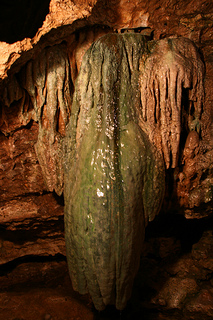Caves and Caverns
Nearly 900 caves and caverns are known to exist in North Carolina, although only a small number are accessible to the public. Linville Caverns, which lies deep within Humpback Mountain in McDowell County, is the most popular underground system in the state. The caverns, which stay at a consistent 52 degrees year round, have been developing intricate stalactite and stalagmite formations over the centuries with names like Frozen Waterfall, Natural Bridge, Franciscan Monk, Monster's Hands, and Shepherd. An underground stream running through the caverns is home to blind trout. Small bats cling to the cavern walls.
 The first recorded exploration of Linville Caverns was made by H. E. Colton, a native of eastern North Carolina, and his local guide, Dave Franklin, in the mid-1800s. During the Civil War, the caverns served as a refuge for deserters from both Union and Confederate armies. According to local legend, an old man lived in the caverns, making and mending shoes for the soldiers. Linville Caverns opened as a tourist attraction on 1 July 1939. Less than a year later, a flood devastated the site and destroyed many nearby homes and businesses. Linville Caverns eventually reopened, becoming one of the most popular attractions in the northern mountains or "High Country."
The first recorded exploration of Linville Caverns was made by H. E. Colton, a native of eastern North Carolina, and his local guide, Dave Franklin, in the mid-1800s. During the Civil War, the caverns served as a refuge for deserters from both Union and Confederate armies. According to local legend, an old man lived in the caverns, making and mending shoes for the soldiers. Linville Caverns opened as a tourist attraction on 1 July 1939. Less than a year later, a flood devastated the site and destroyed many nearby homes and businesses. Linville Caverns eventually reopened, becoming one of the most popular attractions in the northern mountains or "High Country."
Comprised of igneous and metamorphic rocks, Bat Cave in Henderson County is the largest tectonic cave in the state. Mapped passages extend nearly 1.4 miles, and the largest chamber on record is 330 feet long and about 85 feet high. Bat Cave was once the home of a large flock of bats, but most have been driven away or killed by intruders. Rattlesnakes are said to take refuge in the cave during the winter. Privately owned, the cave is protected by the North Carolina Nature Conservancy, which restricts visitors to occasional guided tours.
Another well-known site is Boone's Cave, which overlooks the Yadkin River in 110-acre Boone's Cave State Park in Davidson County. The cave's entrance is 2 to 3 feet high; the cave itself is about 80 feet long and varies in height from 4.5 feet near the entrance to less than 1 foot near its farthest point. It is very narrow, and explorers must crawl along most of the passageway. Legendary frontiersman Daniel Boone is said to have hidden from Indians in the cave, which was also known as "Devil's Den."
Other well-known North Carolina cave and cavern systems include Rock House Cave in Onslow County, Old Blockhouse Cave in Jones County, the Caves in Rumbling Bald Mountain in Rutherford County, Tories Den in Stokes County, and the Wolf's Den in Watauga County.
Reference:
Fred Beyer, North Carolina, the Years before Man: A Geologic History (1991).
Image Credit:
Linville Cavern, 2012. Image courtesy of Flickr user Demonicuss. Available from https://www.flickr.com/photos/demonicuss/7019205877/ (accessed July 10, 2012).
1 January 2006 | Weidman, Rich
